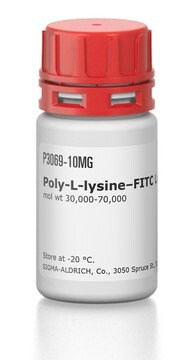P4510
Poly-ε-Cbz-L-lysine
mol wt 500-4,000
Synonym(s):
N6-[(phenylmethoxy)carbonyl]-L-lysine homopolymer
About This Item
Recommended Products
form
powder
mol wt
500-4,000
color
white
storage temp.
−20°C
InChI
1S/C14H20N2O4/c15-12(13(17)18)8-4-5-9-16-14(19)20-10-11-6-2-1-3-7-11/h1-3,6-7,12H,4-5,8-10,15H2,(H,16,19)(H,17,18)/t12-/m0/s1
InChI key
CKGCFBNYQJDIGS-LBPRGKRZSA-N
Looking for similar products? Visit Product Comparison Guide
Application
- Transfection by polyethyleneimine-coated microspheres.: This study explores the use of Poly-e-Cbz-L-lysine in coating microspheres with polyethyleneimine for enhanced cell transfection, demonstrating improved efficiency and potential applications in gene therapy (Manuel WS et al., 2001).
- Transfection of cells mediated by biodegradable polymer materials with surface-bound polyethyleneimine.: The research focuses on biodegradable polymer materials, including Poly-e-Cbz-L-lysine, for cell transfection, highlighting their biodegradability and effectiveness in delivering genetic material (Zheng J et al., 2000).
- Production of microspheres with surface amino groups from blends of Poly(Lactide-co-glycolide) and Poly(epsilon-CBZ-L-lysine) and use for encapsulation.: This paper discusses the creation of microspheres with surface amino groups using blends of Poly-e-Cbz-L-lysine, which are then used for encapsulating active agents, indicating applications in drug delivery systems (Zheng J et al., 1999).
- Modification of materials formed from poly(L-lactic acid) to enable covalent binding of biopolymers: application to high-density three-dimensional cell culture in foams with attached collagen.: The study examines the modification of poly(L-lactic acid) materials with Poly-e-Cbz-L-lysine to covalently bind biopolymers, facilitating high-density 3D cell culture applications (Zheng J et al., 1998).
Analysis Note
Other Notes
Storage Class Code
11 - Combustible Solids
WGK
WGK 3
Flash Point(F)
Not applicable
Flash Point(C)
Not applicable
Personal Protective Equipment
Certificates of Analysis (COA)
Search for Certificates of Analysis (COA) by entering the products Lot/Batch Number. Lot and Batch Numbers can be found on a product’s label following the words ‘Lot’ or ‘Batch’.
Already Own This Product?
Find documentation for the products that you have recently purchased in the Document Library.
Customers Also Viewed
Articles
Humankind has utilized protein materials throughout its existence, starting with the use of materials such as wool and silk for warmth and protection from the elements and continuing with the use of recombinant DNA techniques to synthesize proteins with unique and useful properties.
Our team of scientists has experience in all areas of research including Life Science, Material Science, Chemical Synthesis, Chromatography, Analytical and many others.
Contact Technical Service




